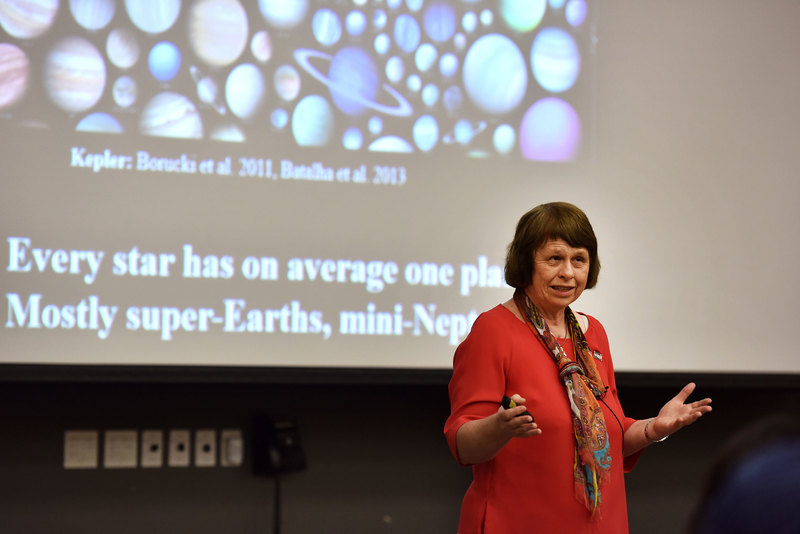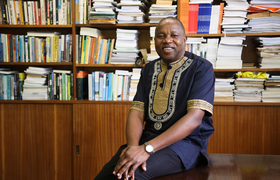Touring outer space
19 February 2020 | Story Niémah Davids. Photo Lerato Maduna. Read time 4 min.
It was blast off from a virtual spacecraft in the New Lecture Theatre at the University of Cape Town (UCT) for a guided tour of outer space to celebrate 50 years of astronomy at UCT.
Aboard were dozens of avid space travellers, including Dean of Science, Professor Maano Ramutsindela; head of UCT’s Department of Astronomy, Professor Patrick Woudt; UCT staff and students, and members of the public.
The group was in good hands as the president of the International Astronomical Union and Professor of Molecular Astrophysics at Leiden University in the Netherlands, Ewine van Dishoeck, hopped into the pilot’s seat.
Van Dishoeck titled her ‘tour’: “Building stars, planets and the ingredients for life in space”.
The year 2020 is a “special year” for South African astronomy; it marks 200 years of the Cape Observatory and 50 years of the astronomy department at the university.
“Today I am going to take you on a tour through space between the stars. It’s really remarkable how little we knew 100 years ago and how much we know about our universe today,” she said.
The solar system
The solar system, which consists of the stars, including the sun, planets, as well as the moon, asteroids and comets, was born in a dark cloud in the Milky Way – the term given to the galaxy that contains our solar system.
Ever wonder if astronomers managed to quantify its age? Van Dishoeck said they have, and the answer is a whopping 4.5 billion years old.
“We can’t see the formation processes anymore, but we can see the outcome of the formation of our solar system.”
But how was the solar system formed?
“We can’t see formation processes anymore, but we can see the outcome of the formation of our solar system, and we see that from material that we have in our inner solar system [like the] meteorites that come from asteroids,” she said.
“Asteroids, meteorites and comets – they all tell us something about our early solar system.”
Stars in the sky
Each individual star consists of a luminous spheroid of plasma held together by their own gravity. Stars are clearly visible with the naked eye from planet earth, and so is the Milky Way.
Van Dishoeck also revealed that more than 200 billion stars make up the Milky Way, and the sun happens to be one of them.
“It [the sun] is located on the outskirts of the galaxy, and we live on this planet circulating this star [the sun],” she said.
Stars don’t have eternal life – they are born, and they eventually die.
“That’s the whole life cycle [of stars] that we are studying. It’s so important because it means we have continuous rejuvenation of stars.”
During her ‘tour’, Van Dishoeck also touched on the Rosetta mission, which made the most detailed study of a comet ever attempted.
Comets, considered to be the blocks on which our solar system is built, most likely ‘seeded’ the Earth with water – and what some scientists believe, even life. Rosetta – by studying the nature of the comet’s dust and gas – will, it is believed, help scientists learn more about the role of comets in the evolution of the solar system.
Water in outer space
Thanks to observations of outer space, and as a result of various active missions, Van Dishoeck said scientists have also established how water is made.
“Once per day a hydrogen atom lands on a tiny dust grain [in space], it finds another hydrogen [atom] and goes off. It also counts on oxygen; it finds oxygen and makes OH and it can make O2. It can make hydrogen peroxide, and [that’s] now going to be water molecules,” she said.
“We’re drinking water molecules that are already 4.5 million years old. The original bond was formed on tiny dust grains, which our solar system collects.”
Astronomy and tech
According to Van Dishoeck, technology plays a vital role in the advancement of astronomy around the globe.
The Atacama Large Millimeter/submillimeter Array (ALMA), a global project to build the most powerful observatory in Earth’s history, is a good example of advancements in the field.
“Tech is everything in astronomy, it drives us forward.”
ALMA is led by a group of scientists and engineers from around the globe with one thing in common: “to understand our cosmic origins”. It’s the first worldwide project in astronomy and aims to capture never-before-seen details about the very first stars and galaxies; probing the heart of the Milky Way galaxy and directly imaging the formation of planets.
ALMA is a transformative radio telescope that can study cosmic light that straddles the boundary between radio and infrared. Van Dishoeck said in just a few hours of observation, ALMA detected thousands of lines in the fingerprint of a young star, and molecules like simple sugars and alcohol in outer space.
“For me, the machine to study star and planet formation, to study astrochemistry is this one,” she said.
“Tech is everything in astronomy, it drives us forward, and astronomy provides perspective, inspiration, excitement and modesty.”
 This work is licensed under a Creative Commons Attribution-NoDerivatives 4.0 International License.
This work is licensed under a Creative Commons Attribution-NoDerivatives 4.0 International License.
Please view the republishing articles page for more information.










